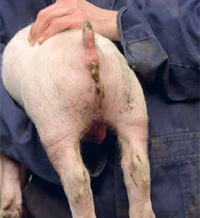The search for alternatives to zinc oxide

In the beginning, the use of zinc oxide in pig production was greeted with some skepticism. Ever since, the method has always remained the subject of pro and con discussions, resulting nowadays in some countries having embraced, banned or re-embraced ZnO. This overview aims to give more insight into its history – and alternatives.
By Dr Ioannis Mavromichalis, international consulting nutriionist, Ariston Nutrition, Spain
Perhaps what Dr Hanne Poulsen presented back in 1989 wasn’t news, but for sure the knowledge was not widely known at the time. At the scientific community at the 40th annual meeting of the European Association for Animal Production in Dublin she said that zinc oxide (ZnO) could stop diarrhoeas in weaned pigs – a long-practiced remedy among some veterinarians. After all, ZnO was already used as a bacteriostatic in human medicine in the form of ointment applied to external cuts and other skin problems. In 1989, it was the first time that this method of controlling diarrhoea in piglets was published in a scientific forum.
To say that the world was taken by this ‘discovery’ is perhaps an overstatement. After all, several skeptics presented data against this ‘novel European practice’. Such was the story of Kansas State University when in 1992 published the data presented in Table 1, only to be followed up by more trials later on that verified what Poulsen and others had already published. By that time, ZnO was becoming a universal method in controlling post-weaning diarrhoeas, not least because it was relatively cheap and readily available.
In fact, in 1993, David Baker and his PhD student Joseph D. Hahn published, again for the first time in the scientific annals, what field nutritionists and producers were experiencing: not only were piglets not affected by post-weaning diarrhoeas, but they also grew faster and more efficiently when fed high levels of Zn from ZnO (Table 2). Since then, ZnO has been considered an indispensable ingredient in almost all types of commercial or home-made piglet diets. It would not be unreasonable to assume that the success of the recent ban on antibiotics in the European Union was at least partially based on our dependency on ZnO to control post-weaning diarrhoeas and promote growth.
Issues with ZnO
Unfortunately, however, not long after its discovery, European regulations were imposed to restrict the use and later ban ZnO from piglet diets for medical and growth-promoting reasons – more about the background on these policies later on. In countries where animal health was not exceptional, and already with limited access to antibiotic options, piglets were constantly crashing post-weaning until some potential alternatives were discovered.
Although ZnO has been allowed back in some European countries since 2005, always under veterinary prescription, efforts continue to find a suitable replacement because current options have not been satisfactory at best. But, in order to find alternatives it is important to understand first why ZnO is undesirable as a piglet feed ingredient and also, how it works once ingested by piglets.
Although ZnO promotes health and performance in piglets, zinc (Zn) remains a heavy metal and as such toxic to most living organisms, including pigs. In fact, according to the US National Research Council, in 1998, feeding pigs with excessive levels of Zn (depending on source) for a prolonged period of time causes symptoms of toxicity from Zn poisoning. As piglet feeds are normally fortified with around 3,000 ppm Zn from ZnO, it is evident that this is bound to cause problems (normal dietary requirement is about 100 ppm Zn). Indeed, and this is based solely on unpublished but repeated observations, feeding 3,000 ppm Zn from ZnO for as short a period as four weeks post-weaning, often causes a marked depression in feed intake towards the end of this period. This is the case especially among pigs exhibiting high feed intake. Obviously, zinc toxicity is not just an issue of Zn concentration in the feed but of actual zinc intake versus time.
Nevertheless, the actual reason why ZnO was banned and (or) restricted in the European Union is because zinc as a heavy metal tends to accumulate in soil after zinc-rich manure from piggeries is applied to the fields. Thus, because high levels of Zn in soil (an due to runoff in water reservoirs) are considered an environmental pollutant and health hazard, the use of ZnO has been severely curtailed in the European Union. This has caused a lot of problems, especially when piglets are removed from one country to another. Such an example are piglets transferred from Denmark (ZnO allowed) to be finished in Germany (ZnO not allowed) and when this happens, digestive upsets, and especially oedema, become the first order of business for German practicing veterinarians receiving these pigs. More recently, it has been demonstrated that prolonged exposure to high levels of Zn can increase some form of resistance in microbes, such as in the case of methicillin resistant Staphylococcus aureus (MRSA). Although this is not of an alarming nature (yet), it does bring into focus the issue of metallo-resistant genes in gram-negative bacteria (such as E. coli), an issue of which more publications are to be expected in the near future.
Replacing ZnO
To successfully replace ZnO, it is key to understand its mode(s) of action; something that eludes us to this day. Indeed, as recently as 2010, XiLong Li and co-workers in a comprehensive review in the Journal of Animal Science and Biotechnology proposed no less than six potential modes of action that could be responsible alone or in any combination for the beneficial effects of ZnO in piglets. What is clear from the list below is that ZnO acts primarily at and through the intestinal level, having both a local and systemic effects on:
1. overall Zn status in weaned piglets,
2. intestinal microbe flora regulation,
3. intestinal structure and function,
4. ion secretion in the intestinal epithelium,
5. intestinal immunology, and
6. secretion of brain-intestine peptides.According to the same authors, the effects of ZnO can be summarised as follows:
“ZnO appears to regulate the intestinal microflora and decrease the release of histamine to prevent diarrhoea. ZnO also increases the expression of intestinal insulin-like growth factor-1 (IGF-1) and the IGF-1 receptor to ameliorate intestinal injury associated with weaning, and mediates secretion of brain-gut peptides to stimulate food intake, to promote the growth of piglets.” Clearly there is a long road before we finally understand how ZnO works, but the need for an effective replacement is immediate and pressing.
Immediate replacements of ZnO A. Organic Zn There is some limited evidence that lower levels of Zn from organic (often chelated) forms may be as effective as Zn from ZnO. The data are not consistent at best, and the claims are not supported by the fact that ZnO from sources of low or high Zn bioavailability sources supports equal performance in young pigs (see Table 3). Clearly, there is more to ZnO than absorbed Zn at the intestinal level. B. Tetra-basic zinc chloride This novel form of Zn has been tested in piglets and results have been quite promising (see Table 4). But, it is not available in the European Union, and according to studies, pigs require at least 1,500 ppm Zn from this source to equal performance obtained by ZnO. Thus, the problems of Zn toxicity and accumulation in soil are less but still present. C. Encapsulated Zinc There is at least more than one source of fat-covered ZnO with claims of comparable results at lower dosages. As Zn absorption does not appear to be the main issue here, as discussed above, and as encapsulation only delays eventual absorption, it is difficult to place this claim in a biological context. Yet, there are some data with interesting results, but not all are positive. D. Nano-Zinc This is a novel idea in that finely ground ZnO can be used at regulation levels (150 ppm in the final feed in the European Union) and still ensure pigs grow better and without diarrhoeas. The theory is that a finely ground ZnO product will expose more molecules of ZnO to interact with the gastro-intestinal tissues and microbial population. For example, normal ZnO has a surface of 4 m2/g, whereas with nano-grinding, this number can be increased to a high, albeit very variable, level. E. High porosity ZnO This concept is used in ZinPot, a new product, launched in November 2010. It is, a standardised form of zinc oxide with an enhanced surface area and more importantly greater porosity (as much as ten times higher than normal ZnO). This gives it even stronger efficacy than nano-zinc as it further increases the possible sites of interaction among the molecules of ZnO, the animal, and microbes in the gastrointestinal tract. Initial trials appear more than promising. A graph showing the potential of this new product is in Figure 1. |











